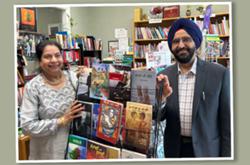What used to be just the fake news business has now evolved into a whole new enterprise — it’s become the spot-the-fake-news industry.
There is so much written about fake news that a journalism website in the U.S. does a weekly round up. Absurdly detailed online guides for spotting pseudo-journalistic inventions are popping up everywhere. Even Facebook has stopped denying its culpability and joined the club. Recently it posted a list of (mostly useless) tips for spotting fabulists on their platform. Incidentally, that list suggests they don’t have the faintest notion how fabricated stories happen.
There’s an excited, breathless quality to the way everyone prattles on about fake news as if it’s this era’s Big Bad. In Germany they’re even drafting a law that would require Facebook and Twitter to delete fake news though it’s not clear how they will define it.
How long will it be before someone publishes the Fake News for Dummies guide? They could do worse than start by examining how a news hoax got traction last month in some legacy media.
Kudos to Gizmodo, Gawker’s tech site, for admitting they were hoodwinked when they blogged another outlet’s scoop in March. After discovering their error, they updated the story to say they couldn’t verify a story about Donald Trump’s lawyers allegedly demanding a teenager take down a crude comic website because it features cat paws batting the President’s head around like a rubber ball. (Playing it is weirdly satisfying.)
“We’re sorry, and we’ll do better,” wrote Gizmodo in a heartfelt mea culpa to its readers. To be fair, they were only repeating the New York Observer’s “exclusive” story as so many others did. (The Observer is a pro-Trump paper that was published by his son-in-law Jared Kushner until this year. The story remains uncorrected on its site.)
Dozens of news sites from New York Magazine to the (London) Telegraph picked it up, which is astonishing since the Observer tale included the single most common marker of fake news: an anonymous source.
In the Observer report, the 17-year-old girl who was supposedly the victim of Trump’s petty behaviour has only a first name, “Lucy.” That’s the journalistic equivalent of a smoke alarm ringing. Responsible newspapers have policies against running anonymous sources, and strict conditions for breaking that rule.
There was no evidence presented that what “Lucy” said was true. Trump’s representatives denied they sent that cease and desist letter (which wasn’t posted). Sure, given that regime’s fondness for alternative facts, they could be lying. But with all the other red flags, this one should have been on the Fake News Watchlist. Instead, outlets that ought to know better just repeated the story, which legitimized it.
Snopes has since joined Gizmodo in debunking the report and other reputable outlets have added corrections to online stories. The wonder is that any journalist repeated a story that was like a template inspired by all the legendary news fabrications.
The Washington Post, which ran Janet Cooke’s infamous Pulitzer-winning story in 1980 about an eight-year-old heroin addict, is the classic cautionary tale. In retrospect, Cooke’s fabricated feature, “Jimmy’s World,” had all the dramatic makings of a movie, which should have made her editors suspicious. It was a little too good to be true, which seasoned editors say is always a red flag.
But what should have definitely sent them in search of little Jimmy was the fact that no one knew his last name.
The same is true of Rolling Stone’s discredited 2014 tale of a gang rape at a University of Virginia fraternity party. Again, they let an unnamed victim (“Jackie”) tell an outrageous tale that echoed the headlines of that moment — Bill Cosby, Jian Ghomeshi, and #rapeculture were all trending.
As creative non-fiction writing goes, Sabrina Erdely’s “A Rape on Campus” was irresistible. It was full of dramatic details that were downright cinematic. The anonymous frat-boy rapists were quoted as referring to the victim in terms reminiscent of Silence of the Lambs — “grab its motherfucking leg,” one of her attackers supposedly said. The “it” referred to the victim, echoing the famous line of that film’s serial killer: “It rubs lotion on its skin, or else it gets the hose.” (Quotes that sound vaguely familiar because they recall movies and novels are another red flag.)
Within days, enterprising reporters at other outlets unravelled the yarn. The magazine and the writer later lost one libel suit and settled another with one of the university’s administrators, who was understandably angry to be painted as a villain for ignoring the imaginary incident.
Of course, names alone are no guarantee someone exists. Stephen Glass’s inventions came with full names and were so elaborate he managed to fabricate at least 27 stories in The New Republic. Still, his editors might have realized they were running fiction had they checked to see if some of his colourful characters existed.
In “Hack Heaven,” a 15-year-old hacker was supposedly hired by Jukt Micronics, a California software company, to show how he breached their firewall. Glass’s tale plays on fears that were common in 1998 about how youth-and-their-damn-computers were taking over the world and getting rich doing it.
A tech writer at Forbes magazine caught Glass when he went looking for Jukt Micronics and found it was software company without a website. As for the pimply teen hacker, who was said to look like a young Bill Gates, someone might have noticed that he sounded like an escapee from the movie Jerry Maguire.
“I want more money. I want a Miata. I want a trip to Disney World,” the young hacker allegedly told the tech company execs at a meeting that Glass witnessed only in his own mind. “I want X-Men comic number one. I want a lifetime subscription to Playboy — and throw in Penthouse. Show me the money! Show me the money!”
That kid had quite a mouth on him. So why didn’t anyone check Glass’s tape recorder to confirm the quote? Or call the kid to check the quote? Or wonder why he sounded like a movie?
All of which is to say, spotting fake news isn’t rocket science. Particularly in the age of Google. If a story seems a little too cinematic, just search the names and places mentioned. And if there are no searchable facts mentioned? Well, you know what that usually means.
© Shannon Rupp. For permission to reprint this article please contact the author: shannon(at)shannonrupp.com. ![]()
Read more: Media
















Tyee Commenting Guidelines
Comments that violate guidelines risk being deleted, and violations may result in a temporary or permanent user ban. Maintain the spirit of good conversation to stay in the discussion.
*Please note The Tyee is not a forum for spreading misinformation about COVID-19, denying its existence or minimizing its risk to public health.
Do:
Do not: